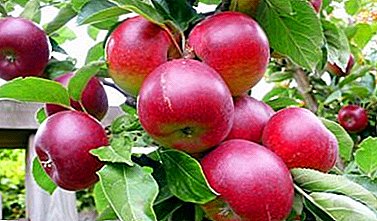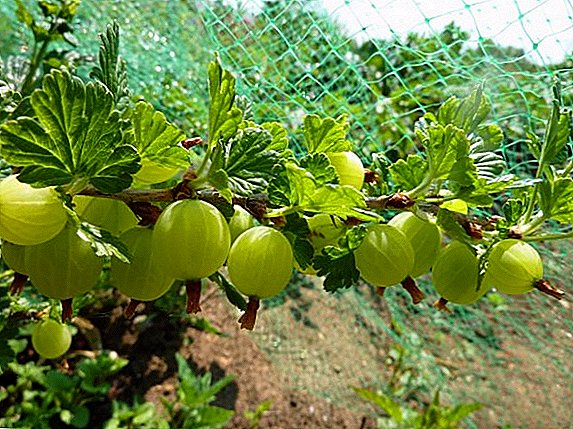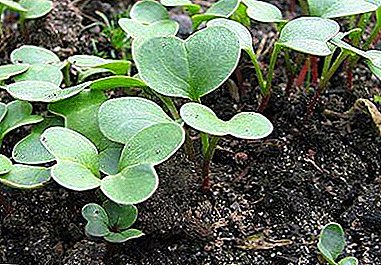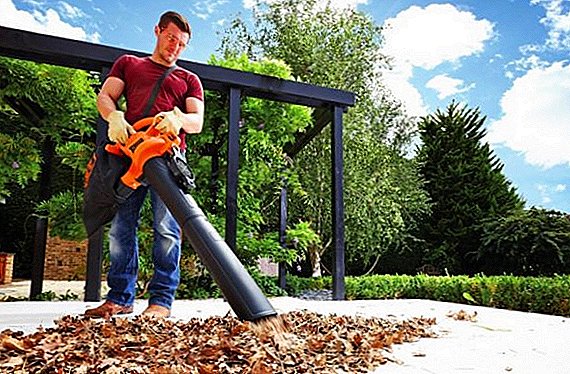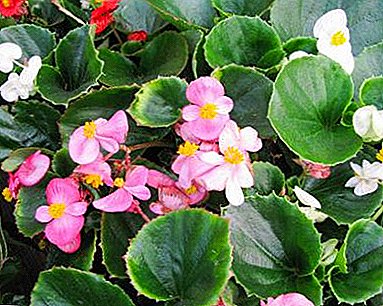
An important condition for the successful cultivation of any indoor plants is the correct choice of soil in which it will grow and develop.
You can prepare an earthen mixture for begonias yourself, or you can purchase a special ready-made substrate in the store.
What should be considered when selecting components for the mixture? How to cook it? Is it worth buying a finished product or is it better to cook yourself?
What firms should pay attention to? These and other questions you will find the answer in this article on the selection of soil for begonias.
How important?
The earth mixture is a breeding ground for the root system of the plant.therefore, it must satisfy all of its micronutrient needs. Each flower requires its own soil composition, depending on the characteristics of its growth and development. Only in a suitable soil containing all the beneficial substances, healthy formation of strong roots that nourish the rest of the plant is possible. When selecting the soil, it is imperative to pay attention to the acidity indicators, correlating them with the numbers necessary for begonia.
The recipes for cooking the land vary depending on the type of begonia: for ever-flowering, royal, tuberous and root begonias, different substrates are prepared with the addition of exactly those chemicals that are needed by a particular variety. For example, some substances cause active budding and prolonged flowering, while others provoke the growth of lush green mass.
If you choose the wrong soil, you can disrupt the whole process of healthy flower development and significantly degrade the decorative qualities of the plant. For this reason, the soil designed for flowering varieties will not be suitable for decorative leafy begonias.
What land is needed?
Begonia has a weak root system., which is sensitive to excessive moisture of the soil. The plant feels comfortable in loose soil enriched with nutrients. The soil should be air and water permeable. The optimum pH is in the range of 6.1 to 7.5.
When self-compiling the substrate must be borne in mind that in the leaf ground should not be tannins, which are contained in willow and oak leaves. Heavy clay soils are not suitable for growing begonias.
Be sure to use drainage, which is placed on the bottom of the pot before laying the soil layer.
Correct composition
 Experienced gardeners often prepare the land on their own, considering all the needs of begonias. Despite the fact that recipes for preparing soil for different species are different, almost all the lists of ingredients contain leafy and soddy soil, humus and peat.
Experienced gardeners often prepare the land on their own, considering all the needs of begonias. Despite the fact that recipes for preparing soil for different species are different, almost all the lists of ingredients contain leafy and soddy soil, humus and peat.
Special additives, such as perlite, vermiculite and river sand will help to make the soil loose. The soil becomes a moisture and breathable field adding sphagnum moss and coconut fiber. Regulate the level of acidity by adding humus, peat and lime.
For the germination of begonia tubers, the soil is prepared from equal parts of sphagnum moss, leaf earth and perlite. To root the cuttings of the plant during cutting, they mix river sand and crushed peat. Royal Begonia develops well in earthy mixconsisting of one part of turf land, two parts of leafy land, two parts of peat and the same amount of humus.
For the cultivation of tuberous begonia prepare the substrate of two parts of leafy land, river sand and one part of turf land. Evergreen begonia develops well in peat, leaf soil, humus and river sand mixed in a ratio of 1: 2: 1: 1.
Options from stores
Buying soil makes it easy, because you do not have to spend a lot of effort on obtaining components for self-preparation.
Basically the store substrate contains bottom peat mixed with mineral additives. This soil is suitable for growing many plants, but its use implies an increase in the number of irrigations, because moisture evaporates from pure peat much faster.
All nutrients are easily and quickly washed out of the substrate, so the begonia growing in the purchased soil needs frequent dressing.
It is easy to choose a suitable substrate in the store: on the package in large letters it will be indicated that it is suitable for begonias.
- Popular substrates from the company "Garden of Miracles". The soil consists of high quality peat mixed with river sand and agroperlite. Biohumus and mineral fertilizers are used as nutritional supplements. For packing 2.5 liters will have to pay 30 rubles.
- Firm "World of Soils" produces soils composed of high and low peat, chalk, dolomite flour, sand and vermiculite.
- Company "Respect" sells substrates for begonias with complex fertilizer called "Sapropel", which consists of peat, sawdust, river sand and additives of organic origin.
- Soil produced by the company "Vermion"made of peat, gravel and biohumus. One package containing 2 liters of land costs about 27 rubles.
Advantages and disadvantages of self-made soil
 Preparing the soil at home is not so difficult, especially if there is a forest or a field nearby. Independently mixed soil has its advantages and disadvantages.
Preparing the soil at home is not so difficult, especially if there is a forest or a field nearby. Independently mixed soil has its advantages and disadvantages.
Advantages:
- can prepare the soil, fully meets the requirements of begonias;
- self-preparation gives confidence in the quality of the components used;
- opportunity to save family budget.
Disadvantages:
- soil from the forest may contain weeds, pests, worms and infections that cause the development of diseases;
- waste of time collecting components.
Step-by-step instructions for preparing the mixture at home
First you need to collect all the components of the future earth mixture.
- Leaf land is taken in forests, parks or under a growing tree, paying attention to a variety of trees (avoiding willows and oaks). For harvesting the soil, an illuminated area under the tree is selected, from which the top layer of leaves fallen in the past leaves is removed.
- The exposed layer of earth is gathered into a container.
- Sod land is taken from meadows and glades, which are at a considerable distance from industrial objects. This type of land is called "mole", so the ideal option is to harvest soil directly from the hillock of the animal's burrow. If the mole hole could not be found, the ground is collected from a well-lit area, overgrown with a small grass, removing a layer of sod in ten - fifteen centimeters.
- Compost or humus is replaced with nutrient soil from the garden or prepared on its own, keeping in mind that humus makes the soil more acidic and contains a large amount of nutrients.Important! The collected earth must be passed through a sieve to get rid of large fragments and pests.
- When everything is collected, proceed to mixing, measuring the exact amount of each component.
- The resulting soil mixture is thoroughly mixed in a large container.
Land preparation for planting indoor flower
Collected in the forest, in the field or in the meadow ground must be sanitized.to get rid of pathogenic bacteria and kill live microorganisms trapped in the soil. Together with the earth you can take with you worms, beetles and other pests that will begin to feast on the root system. The prepared soil mixture purchased in the store is also recommended to be disinfected to completely neutralize the land. There are several methods of disinfection:
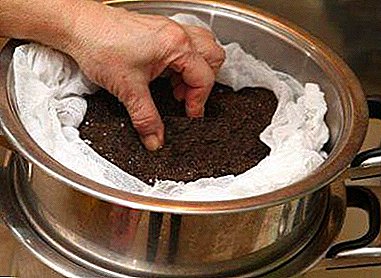 Roasting in the oven at a temperature of one hundred degrees. The soil is spread on a baking sheet with a layer of five centimeters, the oven is heated, after which a baking sheet is placed for thirty minutes.
Roasting in the oven at a temperature of one hundred degrees. The soil is spread on a baking sheet with a layer of five centimeters, the oven is heated, after which a baking sheet is placed for thirty minutes.- Freezing in the freezer. The soil is wrapped in a fabric bag and placed in the refrigerator for five days, after which it is returned to a warm place for a week. This is done in order to "wake up" the eggs of parasites. The cold exposure is repeated by placing the ground in the refrigerator again.
- Warming in the microwave.
- Spilling boiling water.
- Warming up in a water bath for one and a half hours. They put a bucket of water on the fire, above which a grate is placed. On the grid lay the ground, wrapped in cloth.
The disinfected soil needs to be cooled.after which you can safely start using the land. Drainage must be poured at the bottom of the pot to prevent moisture stagnation and root rot. A layer of the prepared substrate is laid on top of the drainage, after which they start planting begonias.
The weak root system of the flower requires careful treatment, so it is necessary to choose the optimal soil composition for the plant in which it will actively grow and please with flowers or decorative leaves.


 Roasting in the oven at a temperature of one hundred degrees. The soil is spread on a baking sheet with a layer of five centimeters, the oven is heated, after which a baking sheet is placed for thirty minutes.
Roasting in the oven at a temperature of one hundred degrees. The soil is spread on a baking sheet with a layer of five centimeters, the oven is heated, after which a baking sheet is placed for thirty minutes.
